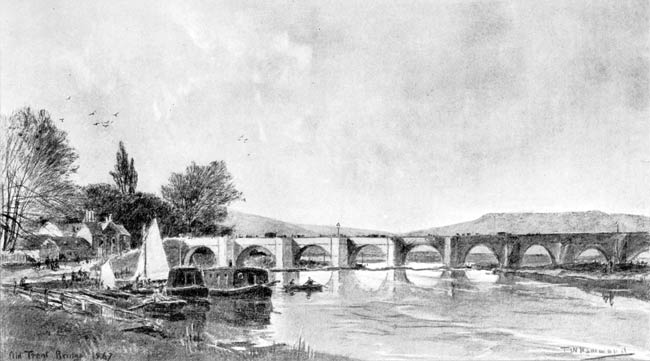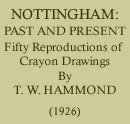< Previous | Contents | Next >
NOTTINGHAM PAST & PRESENT: THE RIVER TRENT
OLD TRENT BRIDGE, West Side, 1869

This drawing is probably one of Mr. Hammond's most charming productions and, in addition to its obvious artistic merit, it gives us some idea of the beauty of the site of Nottingham before modern industrial conditions obtained. It must always be borne in mind that until quite modern times Trent Bridge was some considerable distance away from the town of Nottingham, and until the enclosure of the Lammas fields in the middle of the last century, a belt of some mile or so of agricultural land lay between its northern extremity and the entrance to the town at Hollow Stone. The river Trent (about whose name many guesses have been made, some people saying that is is derived from the thirty tributaries which flow into it while others speak of the thirty different fishes to be found within its waters) was always of the greatest importance in English history, and its crossing near the point occupied by the modern Trent Bridge was of tremendous strategic importance all through the middle ages. Not only was the Trent of military importance, but it served as a legal boundary for the two halves of England which were worked by different judges. The northern half was spoken of in legal language as 'Ultra Trentham', while the southern half was called 'Cintra Trentham'.
The Trent has been both the blessing and the bane of Nottingham, for on its waters was carried the commerce of the middle ages to and from the sea, which made Nottingham prosperous as the port of the whole Midlands, and up its waters also sailed the terrible warships of the Saxons and the keels of the Vikings which wrought such havoc to the land that the suffrage 'From the fury of the Northmen, Good Lord deliver us' was inserted in the Litany. The five arches on the northern side of the Trent Bridge shown in this picture were reconstructed in the year 1683. The river was diverted behind the site now occupied by the Town Arms and in front of the site where, until recently, stood the Union Inn; the workmen were thus enabled to conduct this re-construction at their leisure.
In the background of this picture is shown the woods of Colwick Hill which overhang Colwick Hall, and remind us of Byron's fruitless passion for Mary Chaworth, with all the tragedy and romance of the 'lame boy's' life.
